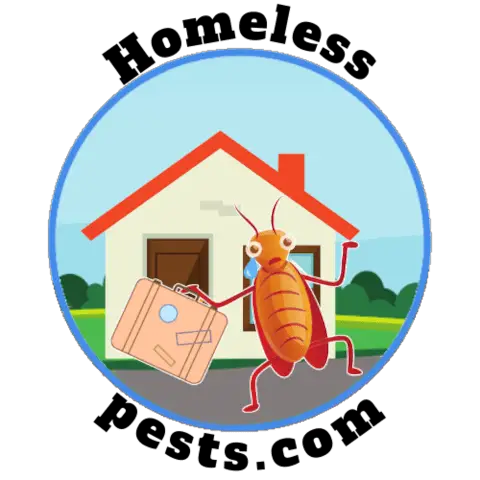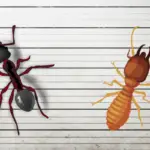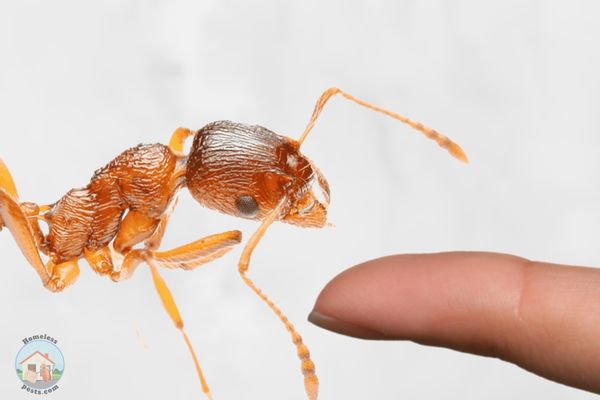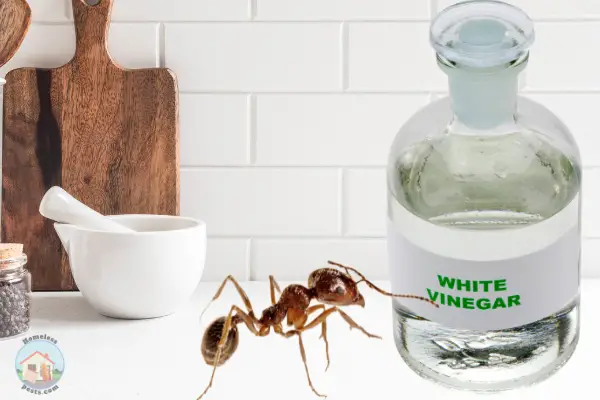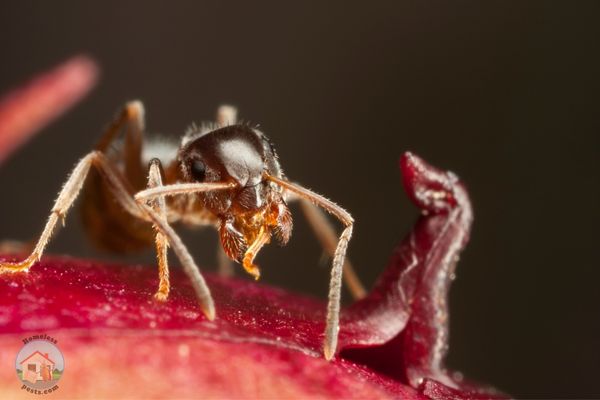As a homeowner living in the right place in the USA, the word “carpenter ant” probably strikes fear in your heart. These silent house destroyers have the potential to cause a lot of damage in our predominantly timber-built homes.
If you’ve ever wondered what a carpenter ant actually was, how it damages properties, and what you can do to prevent this, well you are in the right place.
In this article, I’m going to explore everything that a concerned homeowner needs to know, including how to deal with pesky carpenter ants.
How do I know if it’s a carpenter ant?
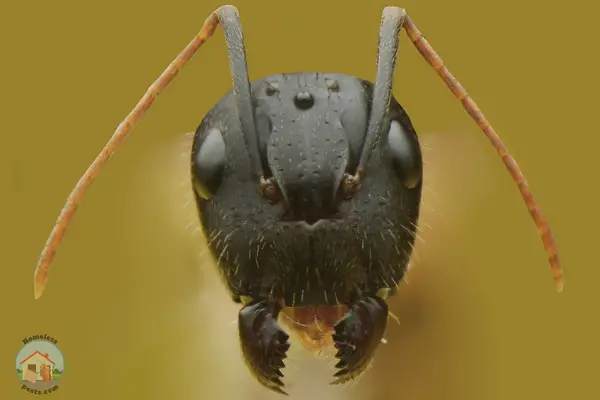
Being able to identify a carpenter ant is important as these critters have the potential to cause much more damage than your average black garden ant. Unfortunately, there are several different species of Carpenter ants in the USA of varying colors and sizes.
What all carpenter ants (belonging to the genus Camponotus) seem to have in common are their round-like thorax and heart shape heads. Apparently, they also have hairs coming out of their anus, but I won’t ask you to get that close to check.
A carpenter ant is among the largest known species of ants in the USA, and as a result, you’d think it was easily identifiable due to its size. However, all the worker carpenter ants can range in size (from one to two centimeters) and so size alone won’t always reveal a carpenter ant.
The surest way to detect a Carpenter ant is to “catch” it in the act of chewing through your wooden structures. This is why I’d recommend you have a regular inspection of your home by a professional pest inspector, especially if you have a general ant problem.
How do you find a carpenter ant nest?
Locating the carpenter ant nest is essential in controlling carpenter ant populations, but it is not always an easy task to complete. If you watch how ants move around, you might be able to figure out where their nest is located just by paying attention to their toing and froing.
Although finding carpenter ant nests can be tricky, but most experts advocate these methods:
Look for the presence of very fine sawdust
The presence of very fine sawdust, known as frass, is a key piece of evidence that you have found the carpenter ant’s nest. This is produced as the ants carve out pathways inside which they can travel, dwell, and deposit their eggs, and it is a solid sign of the existence of a nest in the surrounding area.
Examine any spots where water has gotten in
Nests are typically located in damp, rotting wood. If your home has ever experienced a leak or you notice that the humidity level inside is unusually high, you should start by inspecting these areas. Check the areas surrounding openings, potted plants, crawl spaces, and walls.
Examine the area around and outside your house
Nests built by the mature carpenter ant colonies are typically found outside rather than inside homes. You can find them in locations like decaying logs, dead trees, and rotten woods around your property.
Check your home for the presence of these different types of habitats, and if your property is a mess, get it fixed up as soon as possible. Carpenter ant colonies do spread and new ones are created each year. These weak spots are ideal places for these new colonies to spring up.
Listen and tap woods
You might be able to hear a carpenter ants nest. The continuous crawling or movement of the ants within can be heard as a calm clatter or popping through the floors and walls. If you think carpenter ants are inside a wooden board, tap it and listen for their creaking sounds.
Follow ant trails
Unlike termites, carpenter ants don’t eat wood, they merely use it to create their home. This means that the colony needs to send its foraging worker ants out to find a food source.
If you can find an ant trail, you are more than likely going to find the nest it originated from. When these trails lead straight into your home or a structural element, you need to take action fast!

What Months Are Carpenter Ants Active?
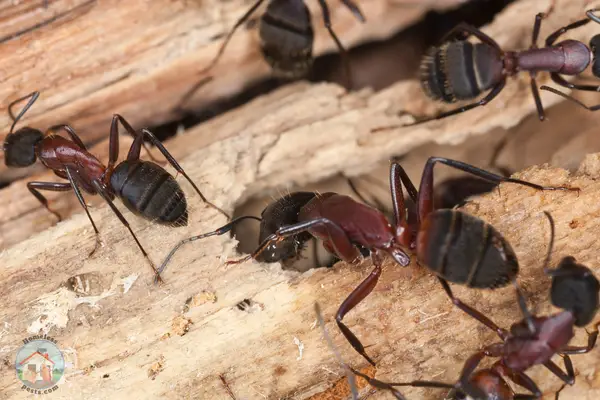
Carpenter ants are mostly active sometime during spring, specifically around March and April, and they will continue to be active until September. Furthermore, if the colony is at least two years old, they will continuously produce winged carpenter ant queens.
These queen ants are escorted by male ones and will separate from their current colony to first mate and then build their own colonies. Read more about flying ants here.
These ants show increased activity throughout spring since a house’s wooden structure is damper at the time. Besides, wood tends to expand in spring, allowing these ants to make their homes with ease. The abundance of water in these areas also helps them survive and stay active.
How Can Carpenter Ants Destroy a House?

Generally, you hear a lot more about termite damage than you do ant damage, but both pests are bad news for our homes. Even when you think you’ve kept a check on their presence in your yard, they still find ways of gaining access to your property.
These ants can enter a house through a wide variety of means. For instance, they might get into your house through a piece of firewood you carried home with you. Your house might also have a few cracks where the ants can get through. In other instances, they might have invaded your home by crossing a tree branch connecting to your home.
This is why it’s important to keep up with your yearly maintenance both inside and outside your home. Whenever you start to see pests in the home it’s a red flag that your perimeter is under attack!
Unlike termites, carpenter ants do not consume wood. Nevertheless, they still destroy your house’s wooden structures by tunneling through them to form their nests or homes. They manage to do this by excavating small pieces of the wood, resulting in the formation of hollow tunnels within it.
If the colony at your home becomes bigger and starts forming more nests within these wooden structures, the structural stability of your home will be negatively impacted. And in worst-case scenarios, your home could get ruined entirely by these ants.
Known as the silent destroyers, it’s not unknown for homes to literally collapse after suffering years of abuse and the hands of these little pests.
For a much more detailed look at the extent of damage carpenter ants can do to your home, read my full article here.
How Long Does It Take for Carpenter Ants to Cause Damage?
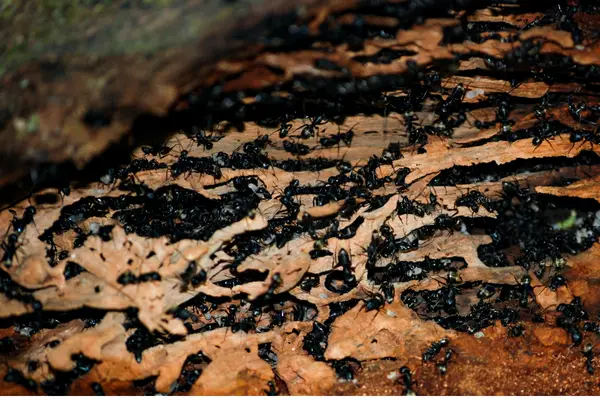
Despite their tiny size, carpenter ants are notorious for quickly burrowing through the wood. However, even though carpenter ants tunnel through wood quickly, it’ll take years before they can actually cause significant damage to your home. It’s most probably why they’re referred to as quiet home destroyers!
With that said, it’s crucial to examine your home immediately for any signs of carpenter ant infestation. Some signs of carpenter ant infestation in your home include the following:
- Presence of wood dust or shavings: Since carpenter ants do not eat wood, they produce wood dust or shavings as they burrow through them. These shavings are often found nearby windows, doors, and baseboards.
- Presence of carpenter ants in your home: Before you panic, do take note that seeing a single carpenter ant doesn’t mean your home is already infested. It may simply mean that they have just managed to enter your home for now. But if you spot more than ten in your home, it’s another sign that your home may already have a colony.
- Hollow-sounding wood: If you spotted the said signs above in your home, try knocking on the wooden surfaces where you saw ants and shavings at. If the wood sounds hollow, it’s another sure sign of infestation.
- Soft rustling sounds behind house walls: In some circumstances, you might also hear soft rustling sounds behind your house walls. These sounds are produced as the ants make these hollow tunnels within the wood.
Do Carpenter Ants Just Go Away?
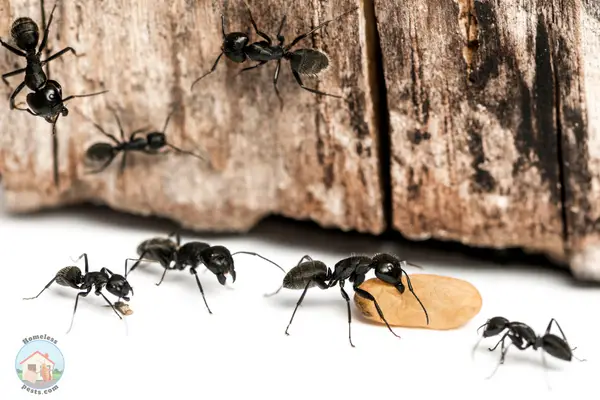
I definitely wouldn’t recommend leaving these home-destroying insects to suddenly decide to leave on their own. As previously mentioned, these ants will continue burrowing through your wooden structures as their colony grows. These colonies can grow to in excess of 50,000 individuals.
And during their most active periods, they will continue to release more winged queens that’ll soon start their own colonies.
Naturally, more winged queen carpenter ants mean more possible colonies forming in your home. Therefore, if you leave these ants thinking they’d go away on their own, you’re making a huge mistake. In fact, you’re just giving them a chance to grow their colony further!
So, if you ever find signs of these ants lurking in your home, it’s best to deal with them as soon as possible. That said, you can eliminate these ants on your own or with the help of a professional. But if you figure that the job is a lot more serious than it looks, it’s best to leave everything in the hands of a professional.

How Do You Keep Carpenter Ants From Coming Back?
As a homeowner, I know what it’s like to successfully treat your home from these pesky carpenter ants. Sweet relief! But then again, despite getting a massive sigh of relief from removing these pests, I still can’t help but think of the next step to ensure these pests never step foot in my house again.
With this in mind, I definitely recommend getting rid of their scent trails next. These trails are created using the ants’ pheromones, allowing them to create a path between their food sources and their nest. You can wipe these trails using essential oils.
Alternatively, you can also use a homemade solution made with dish soap and water. In addition, white vinegar is also a good option for getting rid of ant trails.
After that, make sure to deal with any possible sources of moisture in your home (e.g., house leaks). If any of your wood is damaged from moisture, get them replaced as well. Once you’re done with that, make sure that these carpenter ants can no longer enter your home by taking the following precautions:
- Trimming tree branches extending to your home
- Repairing any cracks and holes in your house’s foundations
- Keeping firewood and other similar materials away from your house
- Getting rid of rotting wood located outside your house
You should also consider spraying a potent ant killer around the outside of your home to form an impenetrable barrier the ants will not want to cross. You can find the best products to form this perimeter over on Amazon.com
Other than that, ensure your house undergoes a thorough inspection twice a year. This ensures that your house remains pest-free, guaranteeing that these quiet home destroyers won’t compromise its structural soundness.
Recommended ant control products

Use this as your first line of defense to bait and kill off ant colonies.
Find the latest deals and prices on Amazon

Liquid insecticides are excellent for building a perimeter around your property and keeping ant colonies in check.
Find the latest deals and prices on Amazon

Stop ants from hiding in walls or cracks by squeezing them out with this insecticide foam.
Find the latest deals and prices on Amazon

Use this gel bait to attract and poison an entire ant colony.
Find the latest deals and prices on Amazon

Use this to flush out ants hiding in walls or cracks.
Find the latest deals and prices on Amazon
How Do I Get Rid of Carpenter Ants if I Can’t Find the Nest?
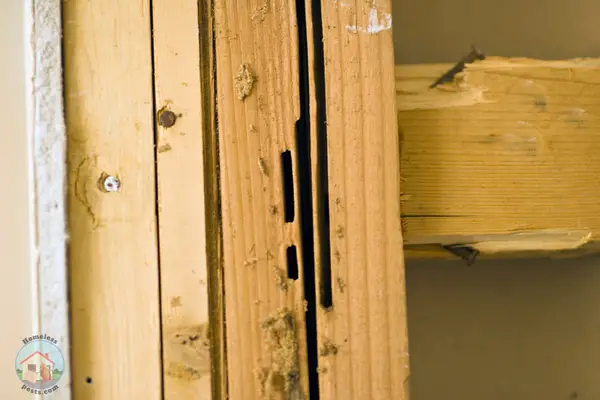
I know the struggle of locating a carpenter ant’s nest. Although it can be easy to spot those tiny frass shavings they produce, pinpointing the exact location of their nest can be quite challenging. And simply relying on the wood dust trails won’t help you as much.
Fortunately, there’s no need for you to break down walls or lift floorboards just to attack a colony’s nest. So, if you want to do the job on your own, you can track their nest by simply baiting them. Ants are fond of sugary food, so you can bait them with sugar or jam. I also recommend using a homemade borax ant killer to poison them as you carry out the next step.
After you’ve laid out your bait, make sure to follow the ants once they get a hold of your bait. From there, you can follow the ants and figure out where their nest is.
If you’ve pinpointed their nest, you will have to drill one-eighth deep holes where the colony’s nest is possibly located. Finally, fill up a bulb duster with boric acid and pump it into the holes you drilled. The boric acid will successfully kill these ants in no time.
If you have any qualms about accurately locating a nest without drilling a lot of unneeded holes in your wooden structures, just call your local professional to do it for you.

Do carpenter ants have wings?
Just like many other species of ants, carpenter ants do sometimes have wings. As a rule, you’ll only ever see carpenter ants with wings that they later shed during their mating season.
So, if they have wings at all, you’ll notice that the back wings of a carpenter ant are significantly shorter than the front wings. This is one of the key ways to distinguish between ants and termites, which have equal-sized wings. Also, the wings of male carpenter ants and their Queen ants are larger than those of the general worker carpenter ants.
Carpenter ants shed their wings in preparation for the process of mating, and once a carpenter ant’s Queen establishes a new nest, she will also shed her wings. If you find several wings piled on your sidewalks, flooring, or any other area it’s a sign that a lot of carpenter ants have taken up residence. You may also find wings caught in the webs that are hanging from your ceilings and walls.
Are winged carpenter ants harmful?
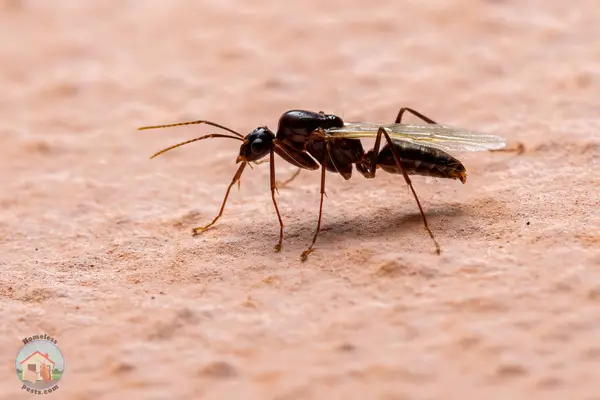
In general carpenter ants are never harmful to humans or even our pets. Biting is a rare occurrence, but there is no denying that these little critters can cause a lot of damage to our homes.
Just remember that carpenter ants with wings and those without are exactly the same but just in different stages of their life cycle. They can cause damage to wooden structures in the same way by tunneling and excavating in order to construct chambers and passageways for their nests.
There is a range of potential damage to wooden constructions. When a colony is allowed to remain in your house for a longer time, the harm caused by carpenter ants with wings will increase, and the damage will be extensive.
In most cases, the damage happens gradually, frequently taking many years to appear. Because they can construct so many nests in such a short amount of time, carpenter ants can rapidly become a significant problem inside a house. This makes them a true hazard.
How do you get rid of carpenter ants with wings?
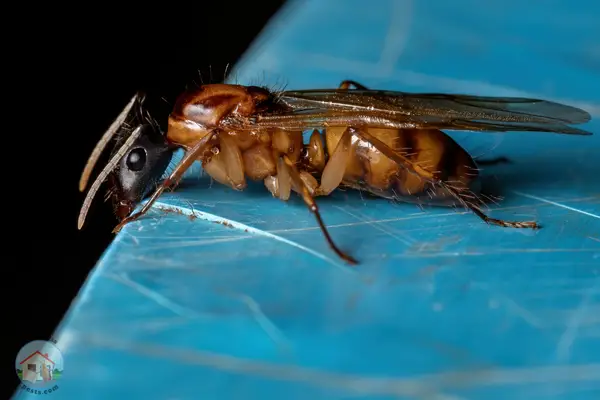
The truth is that you aren’t going to see flying carpenter ants very often or for an extended period of time. It is however the most important time to try and crack down on their populations which are actually in the process of finding new nest sites.
The easiest strategy to prevent carpenter ants with wings from invading your home is to take away all potential food sources and the ideal conditions for nesting. There are also specific ways that need to be used to get rid of flying carpenter ants.
I’d recommend the following methods:
Solve the problems immediately
If you see carpenter ants, whether they are marching or flying, sprinkle some insecticide on them to kill them. Put two teaspoons of salt, one part detergent, and a few droplets of peppermint oil into a spray bottle. Shake the bottle well before each use. Apply this solution to the ants by spraying it. The ants will die of dehydration and suffocation as a result of the grease and soap.
Annihilate their colony
Attacking the colony is the most effective method for getting rid of flying carpenter ants because that is where they grow. Create a bait by combining a sugary ingredient such as honey and the powdered form of borax. The carpenter ants are fooled by the bait and carry it back to their nest with them. Because the borax hampers the digestive cycle of the ants, the entire colony ultimately dies.
Replace any rotten or deteriorating wood
Carpenter ants find the damaged and rotting wood they nest in an ideal environment for raising their young. An overpopulation of carpenter ants is a significant problem because of the damage they can do to wooden structures. As a result, it is essential to repair any deteriorating or rotten wood that is located beneath the flooring or within the walls.
Fill up any cracks and fissures around your house
Be sure to seal any gaps or cracks that you find in the doors, ceilings, or stairs. In addition to this, you should seal any locations that appear like they might be letting carpenter ants from the outside in.
Seek expert assistance
Extermination services provided by professionals come equipped with the knowledge and tools required to eliminate your issue permanently.
For more information about dealing with flying ants and how to enjoy your summer evenings without them landing in your food and drink, please read my full article on the topic.
Final thoughts
Carpenter ants need to be taken very seriously. If you live in areas where they are active, you need to be very diligent about the state of repair of your home.
Although it will take several years to fully destroy a property, the sooner a carpenter ant colony is located the sooner it can be destroyed. As always, the best course of action is to contact your local pest control provider and get the job done right!

source – source – source – source – source – source – source
